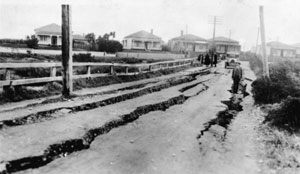1929 Murchison earthquake

On 17 June 1929, at 10.17 a.m., a magnitude 7.8 earthquake struck the northern South Island. It was felt in cities and towns all over New Zealand. Nelson, Westport and Greymouth reported damage, but it was half a day before authorities realised that the worst hit region was Murchison.
For days preceding the earthquake, booming noises had been heard in the hills around Murchison. The earthquake itself was exceptionally noisy: rumblings were heard in New Plymouth, over 250 kilometres away. It was caused by movement along the White Creek Fault west of Murchison. Land moved upward as much as 4.5 metres along the fault.
When the main shock struck, wooden homes warped, twisted and shifted from their piles, and chimneys and water tanks collapsed. People scrambled outdoors, but once there found they were unable to stand.
Document Actions

 Like us on Facebook
Like us on Facebook